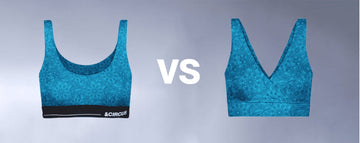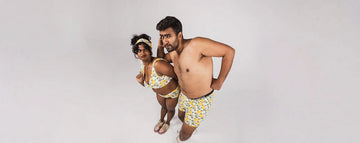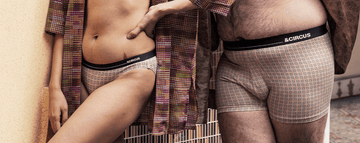Influencers those digital tastemakers who shape what we wear, eat, and even think are turning their spotlight on something unexpectedly personal: hypoallergenic underwear. It's not just about looking good anymore; it's about feeling good, especially for those with sensitive skin or a passion for sustainability. From Instagram reels to TikTok unboxings, these voices are weaving a narrative that blends comfort, health, and eco-consciousness into a single, breathable fabric micromodal.
Uncomfortable underwear shouldn't steal your confidence. At Andcircus, we craft ultra-soft, sustainable Lenzing Modal Micro® innerwear for every body, XS to 5XL. From briefs to bras, our custom packs fit you perfectly. Shop risk-free with our 100% satisfaction guarantee and embrace comfort that includes everyone. #LoveEveryBody. Shop Now!
Influencers Spotlight Hypoallergenic Underwear in Eco-Conscious Campaigns
Social media has become a powerful megaphone for brands crafting innerwear that prioritizes sensitive skin and environmental responsibility. As StyleCraze notes, the best underwear for sensitive skin must be well-fitted, soft, and comfortable to prevent chafing or irritation around delicate areas. This isn't just a niche concern poorly fitting underwear can cause real discomfort, bruising, or worse for those with dermatological sensitivities. Influencers, from wellness gurus to parenting bloggers, are amplifying this message, showcasing how micromodal a sustainable, plant-based fabric delivers on both health and comfort.
The shift isn't just about fabric; it's a cultural pivot. Where once innerwear was an afterthought, it's now a cornerstone of self-care. Influencers are driving this change, sharing raw, relatable stories of their struggles with irritation or their journey toward sustainable living. Their posts whether a candid review of a new maternity brief or a sleek reel showcasing seamless designs are resonating with audiences who want more than just aesthetics from their clothing.
The Rise of Skin-Friendly Innerwear
The demand for hypoallergenic underwear is surging, fueled by growing awareness of skin sensitivities and a broader push for sustainable fashion. Micromodal, derived from beechwood pulp, is emerging as a star player. It's breathable, hypoallergenic, and biodegradable qualities that make it a darling of both dermatologists and environmentalists. Unlike synthetic fabrics that trap heat and bacteria, micromodal wicks moisture and feels like a second skin, a fact that influencers are quick to highlight in their content.
This trend dovetails with a broader cultural shift toward health-conscious consumerism. According to dermatological insights shared across platforms, nearly one in five people report some form of skin sensitivity, from eczema to contact dermatitis. For these individuals, the wrong underwear can turn a day of errands into a battle against itchiness or redness. Influencers are stepping in as educators, breaking down why materials matter and how micromodal's smooth texture reduces friction, offering relief where cotton or polyester might fail.
What's more, the eco-angle is impossible to ignore. Micromodal's sustainable sourcing often from responsibly managed forests aligns with the values of a generation that's increasingly vocal about climate change. Influencers aren't just selling a product; they're selling a lifestyle, one where personal comfort and planetary health go hand in hand.
Influencers in Action: Real Stories, Real Impact
Scroll through TikTok or Instagram, and you'll find wellness influencers slipping into micromodal briefs with the enthusiasm of someone discovering a life hack. Parenting influencers, in particular, have become vocal advocates, especially for maternity wear. One viral reel featured a new mom raving about how her hypoallergenic underwear felt like “wearing a cloud” during her third trimester, easing the discomfort of stretched, sensitive skin. Another influencer, a fitness coach with a focus on clean living, shared a side-by-side comparison of synthetic versus micromodal underwear, pointing out how the latter stayed odor-free even after a sweaty workout.
These moments aren't just content they're conversations. Brands are leaning into this by partnering with influencers who embody their values. A recent campaign saw a sustainable innerwear brand collaborate with a plus-size fashion influencer to showcase inclusive sizing, earning thousands of shares for its body-positive message. Another brand tapped a dermatologist-influencer to explain why micromodal's hypoallergenic properties make it a game-changer for eczema sufferers. These partnerships feel less like ads and more like trusted recommendations, which is exactly why they work.
Navigating the Influencer Ecosystem
But it's not all seamless. The influencer world is a tightrope walk between authenticity and commercialism. When a wellness blogger gushes about a brand, is it genuine love or a paid plug? Audiences are savvy they can smell inauthenticity a mile away. The most effective influencers are those who weave personal stories into their endorsements, like the mom who shared how switching to micromodal spared her postpartum skin from irritation. These narratives build trust, but they also raise the stakes for brands to deliver on their promises.
Then there's the issue of “hypoallergenic” itself a term that's loosely regulated and often misunderstood. Some brands slap the label on without rigorous testing, leading to skepticism among consumers. Influencers who take the time to explain certifications, like OEKO-TEX standards or dermatological endorsements, are doing more than promoting they're educating. This is especially critical when reaching diverse audiences, from men seeking breathable boxer briefs to nonbinary folks looking for gender-neutral options. Inclusive content that reflects varied body types and identities is no longer optional; it's a baseline expectation.
Opportunities for Brands and Consumers
For brands, the influencer boom is a goldmine if they play it right. Micro-influencers, with their smaller but fiercely loyal followings, are proving especially effective. A parenting blogger with 10,000 followers might not have the reach of a celebrity, but their word carries weight in tight-knit communities. Brands that invest in transparent sourcing detailing where their beechwood comes from or how their dyes are non-toxic are winning over these niche audiences. Certifications matter, too; a single post highlighting a dermatologist-approved fabric can spark a flurry of orders.
For consumers, the benefits are tangible. Influencers are demystifying labels, teaching people to look for terms like “micromodal” or “Tencel” instead of settling for vague “soft fabric” claims. This empowerment is especially evident in maternity communities, where women share tips on avoiding chafing during pregnancy. As StyleCraze points out, badly fitted underwear can bruise sensitive skin, a problem micromodal sidesteps with its smooth, stretchy weave. The result? Consumers feel seen, heard, and equipped to make better choices.
A Memorable The Future of Conscious Comfort
The rise of hypoallergenic underwear isn't just a trend it's a testament to how far we've come in prioritizing what touches our skin. Influencers, with their knack for turning personal stories into universal truths, have become the bridge between eco-conscious brands and consumers craving comfort. They're not just selling underwear; they're selling a promise: that you can feel good in your skin and do good for the planet at the same time.
Looking ahead, the possibilities are as exciting as they are practical. Imagine AI-driven platforms matching brands with influencers whose followers align perfectly with their ethos, or apps that recommend underwear based on your skin type and lifestyle. The future of innerwear is inclusive, sustainable, and deeply personal and it's being shaped one post, one story, one perfectly fitted pair at a time. For brands in the micromodal space, the message is clear: lean into authenticity, back your claims with science, and let the influencers tell the world why comfort is the ultimate luxury.
Frequently Asked Questions
Why are influencers promoting hypoallergenic underwear options?
Influencers are highlighting hypoallergenic underwear to raise awareness about skin sensitivity and allergies caused by synthetic fabrics or harsh dyes. Their endorsements often emphasize comfort, breathability, and the importance of skin-safe materials in intimate wear.
What makes underwear hypoallergenic and suitable for sensitive skin?
Hypoallergenic underwear is typically made from natural or certified non-irritating fabrics like organic cotton or micromodal, and is free from harsh chemicals, dyes, or synthetic blends that can cause rashes or itching. These qualities make them ideal for individuals with sensitive skin or allergies.
How do influencer campaigns impact consumer choices in intimate wear?
Influencer campaigns help educate consumers by sharing personal experiences and product reviews, which often lead to increased trust and adoption of hypoallergenic underwear options. Their content also helps brands reach wider, more targeted audiences seeking skin-friendly and sustainable alternatives.
Disclaimer: The above helpful resources content contains personal opinions and experiences. The information provided is for general knowledge and does not constitute professional advice.
You may also be interested in: Triangle vs. Padded Plunge: Choosing the Right Bra Style
Uncomfortable underwear shouldn't steal your confidence. At Andcircus, we craft ultra-soft, sustainable Lenzing Modal Micro® innerwear for every body, XS to 5XL. From briefs to bras, our custom packs fit you perfectly. Shop risk-free with our 100% satisfaction guarantee and embrace comfort that includes everyone. #LoveEveryBody. Shop Now!







































